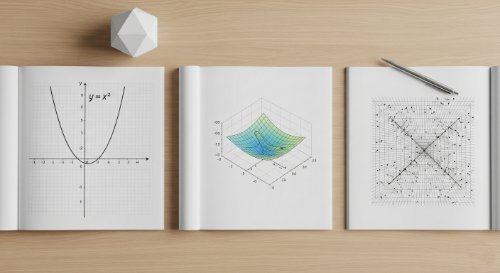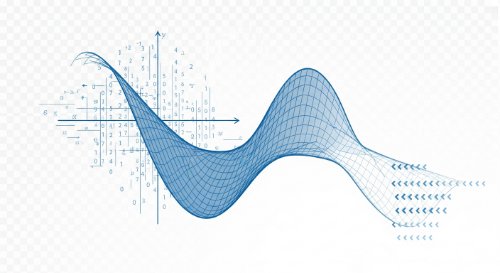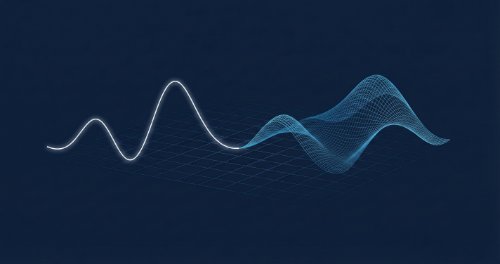Partial Differentiation and Its Applications - Multivariable Calculus (Undergraduate Advanced)
30
22 hrs
 MTH 201: Mathematical Methods IThis learning track delivers the complete mathematical toolkit required for a university-level science, engineering, or computing degree. It systematically covers the entire MTH 201 curriculum, building from the foundational principles of single-variable calculus - functions, limits, continuity, and differentiability - to the advanced methods of multivariable calculus, infinite series, numerical methods, and ordinary differential equations. This is the definitive preparation for advanced quantitative study.
This programme is designed for second-year students offering MTH 201 at Obafemi Awolowo University, Ile-Ife, Nigeria. It is also helpful for any student in a STEM field - including physics, engineering, and computer science - who requires a rigorous and comprehensive command of calculus and its applications.
This track delivers a full skill set in mathematical analysis and applied problem-solving. Graduates will be able to solve a wide range of problems, from optimising multivariable functions to modelling dynamic systems with differential equations and testing the convergence of infinite series. This programme directly prepares students for success in advanced courses in vector calculus, partial differential equations, and real analysis, providing the necessary foundation for a career in engineering, data science, or theoretical physics.
MTH 201: Mathematical Methods IThis learning track delivers the complete mathematical toolkit required for a university-level science, engineering, or computing degree. It systematically covers the entire MTH 201 curriculum, building from the foundational principles of single-variable calculus - functions, limits, continuity, and differentiability - to the advanced methods of multivariable calculus, infinite series, numerical methods, and ordinary differential equations. This is the definitive preparation for advanced quantitative study.
This programme is designed for second-year students offering MTH 201 at Obafemi Awolowo University, Ile-Ife, Nigeria. It is also helpful for any student in a STEM field - including physics, engineering, and computer science - who requires a rigorous and comprehensive command of calculus and its applications.
This track delivers a full skill set in mathematical analysis and applied problem-solving. Graduates will be able to solve a wide range of problems, from optimising multivariable functions to modelling dynamic systems with differential equations and testing the convergence of infinite series. This programme directly prepares students for success in advanced courses in vector calculus, partial differential equations, and real analysis, providing the necessary foundation for a career in engineering, data science, or theoretical physics.
This learning track delivers the complete mathematical toolkit required for a university-level science, engineering, or computing degree. It systematically covers the entire MTH 201 curriculum, building from the foundational principles of single-variable calculus - functions, limits, continuity, and differentiability - to the advanced methods of multivariable calculus, infinite series, numerical methods, and ordinary differential equations. This is the definitive preparation for advanced quantitative study. This programme is designed for second-year students offering MTH 201 at Obafemi Awolowo University, Ile-Ife, Nigeria. It is also helpful for any student in a STEM field - including physics, engineering, and computer science - who requires a rigorous and comprehensive command of calculus and its applications. This track delivers a full skill set in mathematical analysis and applied problem-solving. Graduates will be able to solve a wide range of problems, from optimising multivariable functions to modelling dynamic systems with differential equations and testing the convergence of infinite series. This programme directly prepares students for success in advanced courses in vector calculus, partial differential equations, and real analysis, providing the necessary foundation for a career in engineering, data science, or theoretical physics.
 GET 209: Engineering Mathematics IMaster the mathematical language of engineering. This programme delivers the complete analytical toolkit required for a successful engineering career, covering single-variable calculus, multivariable calculus, linear algebra, and vector analysis. It provides the essential foundation for all subsequent engineering courses.
This programme is for second-year undergraduate students across all engineering disciplines. It delivers the official NUC CCMAS curriculum for Engineering Mathematics, providing the core training required for advanced modules in mechanics, thermodynamics, and circuit theory.
Model and analyse complex physical systems using calculus, linear algebra, and vector analysis. You will be equipped to solve problems in dynamics, statics, and field theory, providing the quantitative proficiency required for advanced engineering study and professional practice.
GET 209: Engineering Mathematics IMaster the mathematical language of engineering. This programme delivers the complete analytical toolkit required for a successful engineering career, covering single-variable calculus, multivariable calculus, linear algebra, and vector analysis. It provides the essential foundation for all subsequent engineering courses.
This programme is for second-year undergraduate students across all engineering disciplines. It delivers the official NUC CCMAS curriculum for Engineering Mathematics, providing the core training required for advanced modules in mechanics, thermodynamics, and circuit theory.
Model and analyse complex physical systems using calculus, linear algebra, and vector analysis. You will be equipped to solve problems in dynamics, statics, and field theory, providing the quantitative proficiency required for advanced engineering study and professional practice.
Master the mathematical language of engineering. This programme delivers the complete analytical toolkit required for a successful engineering career, covering single-variable calculus, multivariable calculus, linear algebra, and vector analysis. It provides the essential foundation for all subsequent engineering courses. This programme is for second-year undergraduate students across all engineering disciplines. It delivers the official NUC CCMAS curriculum for Engineering Mathematics, providing the core training required for advanced modules in mechanics, thermodynamics, and circuit theory. Model and analyse complex physical systems using calculus, linear algebra, and vector analysis. You will be equipped to solve problems in dynamics, statics, and field theory, providing the quantitative proficiency required for advanced engineering study and professional practice.
 MTH 201: Mathematical Methods IMastering advanced calculus is essential for modelling complex systems in science and engineering. This track delivers the rigorous mathematical foundation demanded by the official NUC CCMAS curriculum for MTH 201. It systematically builds your expertise from fundamental single-variable theory to the sophisticated multivariable analysis used to solve critical problems in physics, economics, and technology.
This programme is for undergraduates in engineering, mathematics, physics, and computer science requiring a deep theoretical and practical command of calculus. It also serves economics students needing advanced quantitative tools or professionals in finance and data science seeking a solid mathematical base for technical research.
You will gain the analytical skills to construct formal proofs for differentiation rules and apply cornerstone theorems like Mean Value and Taylor's. You will master multivariable techniques, enabling you to solve constrained optimization problems with Lagrange multipliers and compute multiple integrals across line, surface, and volume domains. This track is the requisite preparation for advanced studies in differential equations, vector analysis, and complex engineering modelling.
MTH 201: Mathematical Methods IMastering advanced calculus is essential for modelling complex systems in science and engineering. This track delivers the rigorous mathematical foundation demanded by the official NUC CCMAS curriculum for MTH 201. It systematically builds your expertise from fundamental single-variable theory to the sophisticated multivariable analysis used to solve critical problems in physics, economics, and technology.
This programme is for undergraduates in engineering, mathematics, physics, and computer science requiring a deep theoretical and practical command of calculus. It also serves economics students needing advanced quantitative tools or professionals in finance and data science seeking a solid mathematical base for technical research.
You will gain the analytical skills to construct formal proofs for differentiation rules and apply cornerstone theorems like Mean Value and Taylor's. You will master multivariable techniques, enabling you to solve constrained optimization problems with Lagrange multipliers and compute multiple integrals across line, surface, and volume domains. This track is the requisite preparation for advanced studies in differential equations, vector analysis, and complex engineering modelling.
Mastering advanced calculus is essential for modelling complex systems in science and engineering. This track delivers the rigorous mathematical foundation demanded by the official NUC CCMAS curriculum for MTH 201. It systematically builds your expertise from fundamental single-variable theory to the sophisticated multivariable analysis used to solve critical problems in physics, economics, and technology. This programme is for undergraduates in engineering, mathematics, physics, and computer science requiring a deep theoretical and practical command of calculus. It also serves economics students needing advanced quantitative tools or professionals in finance and data science seeking a solid mathematical base for technical research. You will gain the analytical skills to construct formal proofs for differentiation rules and apply cornerstone theorems like Mean Value and Taylor's. You will master multivariable techniques, enabling you to solve constrained optimization problems with Lagrange multipliers and compute multiple integrals across line, surface, and volume domains. This track is the requisite preparation for advanced studies in differential equations, vector analysis, and complex engineering modelling.
Course Chapters
1. Introduction4
Meaning of real-valued functions of several variables - domain, range, graphs, level curves, surfaces and computer-aided visualizations.
Chapter lessons
1-2. Multivariable functions15:35
2. Limits35
Formal and informal definitions, evaluation of limits of functions of several variables.
Chapter lessons
3. Continuity12
4. Partial Derivatives34
Formal definition of differentiability for functions of several variables; notations and evaluation of first and higher-order partial derivatives.
Chapter lessons
5. Composite Functions13
Partial derivatives of composite functions of several variables - chain rule of differentiation.
Chapter lessons
5-1. Chain rule27:31
Chain rule of differentiation for partial derivatives.
6. Implicit Differentiation44
Differentiation of implicitly-defined functions of several variables and an introduction to the Jacobian determinant.
Chapter lessons
6-1. Two variables28:29
Implicit differentiation of a function with one dependent variable and one independent variable using partial derivatives.
6-2. Jacobian Determinants6:38
Definition and evaluation of Jacobian determinants.
6-3. Three variables24:46
Implicit differentiation of a function with two dependent variables and one independent variable using partial derivatives.
6-4. Several variables11:13
General implicit differentiation of a function with several dependent and independent variables using Jacobian determinants.
7. Theorems on Jacobians33
Some theorems on Jacobian determinants - the implicit function theorem and its implications.
Chapter lessons
7-1. Existence of solutions19:50
Examining the existence of solutions of a linear system of equations and its relation to the Jacobian determinant.
7-2. The implicit function theorem11:50
The implicit function for a system of implicit functions.
7-3. Other theorems11:53
Other theorems on the Jacobian determinant.
8. Homogeneous Functions22
Meaning of homogeneous functions; Euler's theorem for homogeneous functions.
Chapter lessons
8-1. Definition10:01
Meaning of homogeneous functions - identifying the order of homogeneous functions.
8-2. Euler's theorem7:47
Euler's theorem for homogeneous functions.
9. Taylor's Theorem12
Taylor's theorem for functions of two variables.
Chapter lessons
9-1. Theorem22:44
Taylor's theorem for a function of two variables.
10. Extreme Values22
Getting the stationary points of a function of several variables by application of partial derivatives.
Chapter lessons
10-1. Maxima and minima28:34
How to find the stationary points of a function of two variables.
10-2. Procedure7:26
How to determine the stationary points of a two-variable function - and the nature of the stationary points.
11. Lagrange Multipliers12
Getting the stationary points of a function of several variables subject to some condition by application of partial derivatives and the method of Lagrange multipliers.
Chapter lessons
11-1. Method6:57
The method of Lagrange multiplier for examining stationary points of a function of two variables subject to a constraint.
12. Gradients and Directional Derivatives22
Applications of partial derivatives - gradient of a differentiable function and its relation to the directional derivative.
Chapter lessons
12-1. The gradient vector8:03
Definition of the gradient vector for a function of several variables.
12-2. Directional derivative22:15
Definition of the directional derivative of a function of several variables, its maximum value and what direction it occurs.
13. Applications to Geometry73
Equations of lines, planes, curves and surfaces in three-dimensional Cartesian coordinates - vector, standard and parametric equations.
Chapter lessons
13-1. Equation of a straight line39:41
Vector (three-dimensional) equations of a straight line, and why y=mx+c no longer cuts it.
13-2. Equation of a plane20:43
Equation of a plane - vector and standard forms.
13-3. Equation of a curve15:10
Derivation and visualization of the parametric equations of curves in three dimensions and how they are related to those of straight lines; direction of the derivative of the parametric equation of a curve.
13-4. Equation of a surface17:19
Equation of a surface, in contrast to a plane; the direction of the gradient vector of a surface at a given point.
13-5. Intersection of surfaces26:52
Lines formed by intersection of surfaces and their tangent vector.
13-6. Tangent line and normal plane to a curve29:42
Equations of the tangent line and normal plane to a curve.
13-7. Tangent plane and normal line to a surface11:46
Equations of the tangent plane and normal line to a surface.